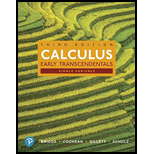
Calculus: Single Variable, Early Transcendentals and MyLab Math with Pearson eText -- Title-Specific Access Card Package (3rd Edition) (Briggs, Cochran, Gillett & Schulz, Calculus Series)
3rd Edition
ISBN: 9780134996714
Author: William L. Briggs, Lyle Cochran, Bernard Gillett, Eric Schulz
Publisher: PEARSON
expand_more
expand_more
format_list_bulleted
Question
Chapter C, Problem 33E
To determine
To compute: The polar form of the
Expert Solution & Answer
Want to see the full answer?
Check out a sample textbook solution
Students have asked these similar questions
Find a plane containing the point (3, -3, 1) and the line of intersection of the planes 2x + 3y - 3z = 14
and -3x - y + z = −21.
The equation of the plane is:
Determine whether the lines
L₁ : F(t) = (−2, 3, −1)t + (0,2,-3) and
L2 : ƒ(s) = (2, −3, 1)s + (−10, 17, -8)
intersect. If they do, find the point of intersection.
● They intersect at the point
They are skew lines
They are parallel or equal
Answer questions 2
Chapter C Solutions
Calculus: Single Variable, Early Transcendentals and MyLab Math with Pearson eText -- Title-Specific Access Card Package (3rd Edition) (Briggs, Cochran, Gillett & Schulz, Calculus Series)
Ch. C - Practice Exercises Complex operations Let z = 2 +...Ch. C - Prob. 2ECh. C - Prob. 3ECh. C - Prob. 4ECh. C - Prob. 5ECh. C - Prob. 6ECh. C - Prob. 7ECh. C - Prob. 8ECh. C - Prob. 9ECh. C - Prob. 10E
Ch. C - Prob. 11ECh. C - Prob. 12ECh. C - Prob. 13ECh. C - Prob. 14ECh. C - Prob. 15ECh. C - Prob. 16ECh. C - Prob. 17ECh. C - Prob. 18ECh. C - Prob. 19ECh. C - Prob. 20ECh. C - Prob. 21ECh. C - Prob. 22ECh. C - Prob. 23ECh. C - Prob. 24ECh. C - Prob. 25ECh. C - Prob. 26ECh. C - Prob. 27ECh. C - Prob. 28ECh. C - Prob. 29ECh. C - Prob. 30ECh. C - Prob. 31ECh. C - Prob. 32ECh. C - Prob. 33ECh. C - Prob. 34ECh. C - Prob. 35ECh. C - Prob. 36ECh. C - Prob. 37ECh. C - Prob. 38ECh. C - Prob. 39ECh. C - Prob. 40ECh. C - Prob. 41ECh. C - Prob. 42ECh. C - Prob. 43ECh. C - Prob. 44ECh. C - Prob. 45ECh. C - Prob. 46ECh. C - Prob. 47ECh. C - Prob. 48ECh. C - Prob. 49ECh. C - Prob. 50ECh. C - Prob. 51ECh. C - Prob. 52ECh. C - Prob. 53ECh. C - Prob. 54ECh. C - Prob. 55ECh. C - Prob. 56ECh. C - Prob. 57ECh. C - Prob. 58ECh. C - Prob. 59ECh. C - Prob. 60ECh. C - Prob. 61E
Knowledge Booster
Learn more about
Need a deep-dive on the concept behind this application? Look no further. Learn more about this topic, calculus and related others by exploring similar questions and additional content below.Similar questions
- How does a fourier transform works?arrow_forwardDetermine the radius of convergence of a power series:12.6.5, 12.6.6, 12.6.7, 12.6.8Hint: Use Theorem12.5.1 and root test, ratio test, integral testarrow_forwardCan you answer this question and give step by step and why and how to get it. Can you write it (numerical method)arrow_forward
- Can you answer this question and give step by step and why and how to get it. Can you write it (numerical method)arrow_forwardThere are three options for investing $1150. The first earns 10% compounded annually, the second earns 10% compounded quarterly, and the third earns 10% compounded continuously. Find equations that model each investment growth and use a graphing utility to graph each model in the same viewing window over a 20-year period. Use the graph to determine which investment yields the highest return after 20 years. What are the differences in earnings among the three investment? STEP 1: The formula for compound interest is A = nt = P(1 + − − ) n², where n is the number of compoundings per year, t is the number of years, r is the interest rate, P is the principal, and A is the amount (balance) after t years. For continuous compounding, the formula reduces to A = Pert Find r and n for each model, and use these values to write A in terms of t for each case. Annual Model r=0.10 A = Y(t) = 1150 (1.10)* n = 1 Quarterly Model r = 0.10 n = 4 A = Q(t) = 1150(1.025) 4t Continuous Model r=0.10 A = C(t) =…arrow_forwardUse a graphing utility to find the point of intersection, if any, of the graphs of the functions. Round your result to three decimal places. (Enter NONE in any unused answer blanks.) y = 100e0.01x (x, y) = y = 11,250 ×arrow_forward
- 5. For the function y-x³-3x²-1, use derivatives to: (a) determine the intervals of increase and decrease. (b) determine the local (relative) maxima and minima. (e) determine the intervals of concavity. (d) determine the points of inflection. (e) sketch the graph with the above information indicated on the graph.arrow_forwardCan you solve this 2 question numerical methodarrow_forward1. Estimate the area under the graph of f(x)-25-x from x=0 to x=5 using 5 approximating rectangles Using: (A) right endpoints. (B) left endpoints.arrow_forward
- 9. Use fundamental theorem of calculus to find the derivative d a) *dt sin(x) b)(x)√1-2 dtarrow_forward3. Evaluate the definite integral: a) √66x²+8dx b) x dx c) f*(2e* - 2)dx d) √√9-x² e) (2-5x)dx f) cos(x)dx 8)²₁₂√4-x2 h) f7dx i) f² 6xdx j) ²₂(4x+3)dxarrow_forward2. Consider the integral √(2x+1)dx (a) Find the Riemann sum for this integral using right endpoints and n-4. (b) Find the Riemann sum for this same integral, using left endpoints and n=4arrow_forward
arrow_back_ios
SEE MORE QUESTIONS
arrow_forward_ios
Recommended textbooks for you
- Algebra & Trigonometry with Analytic GeometryAlgebraISBN:9781133382119Author:SwokowskiPublisher:Cengage

Algebra & Trigonometry with Analytic Geometry
Algebra
ISBN:9781133382119
Author:Swokowski
Publisher:Cengage
Complex Numbers In Polar - De Moivre's Theorem; Author: The Organic Chemistry Tutor;https://www.youtube.com/watch?v=J6TnZxUUzqU;License: Standard YouTube License, CC-BY